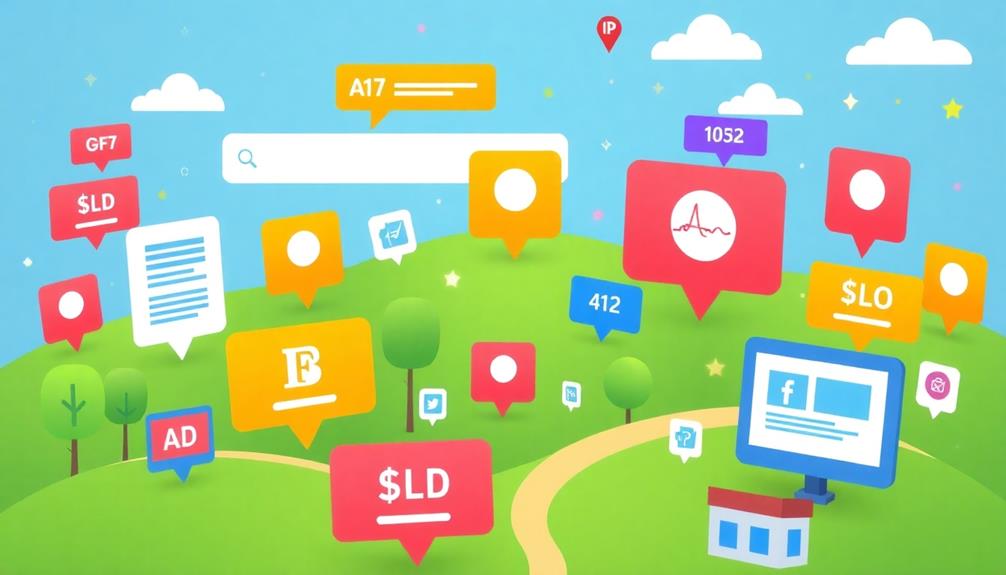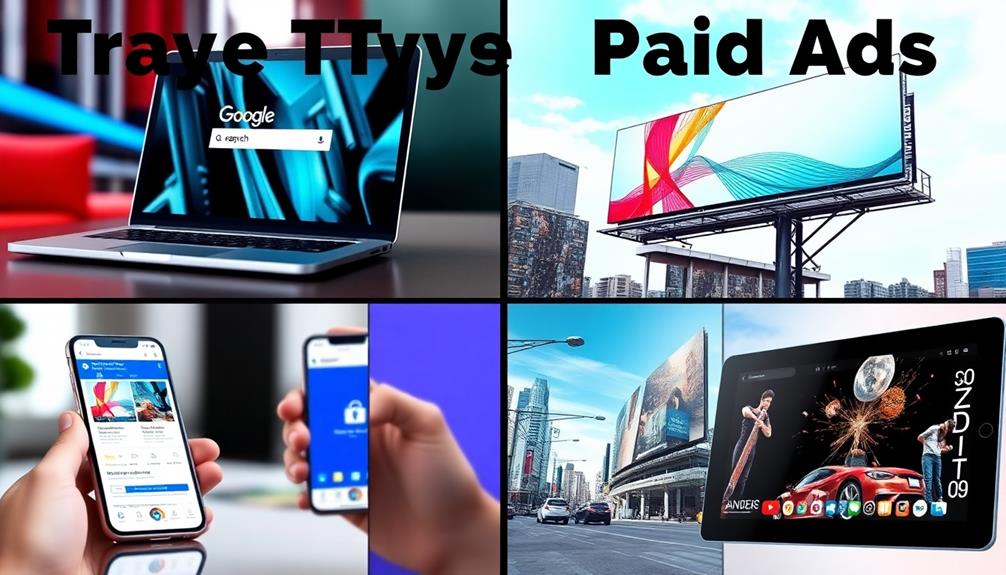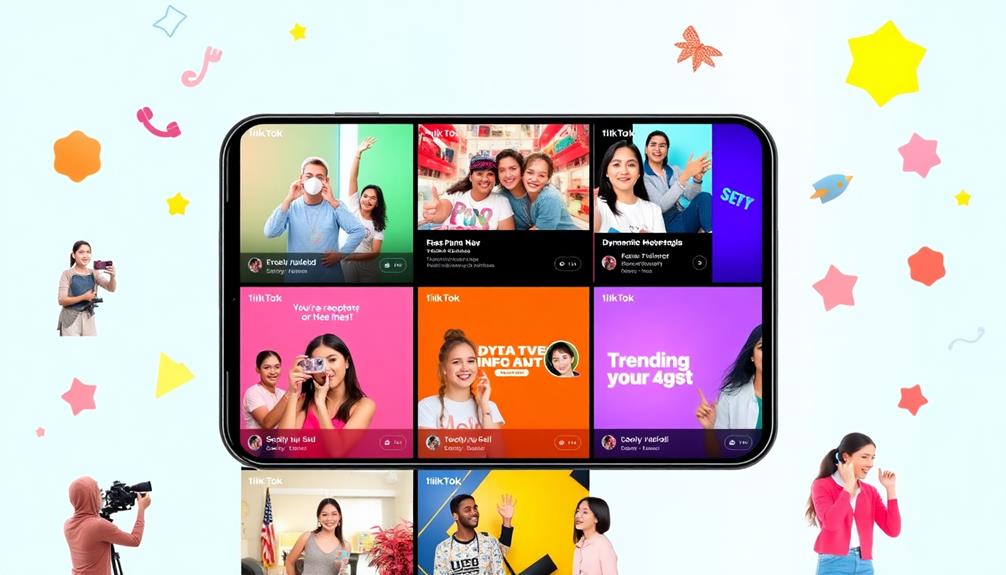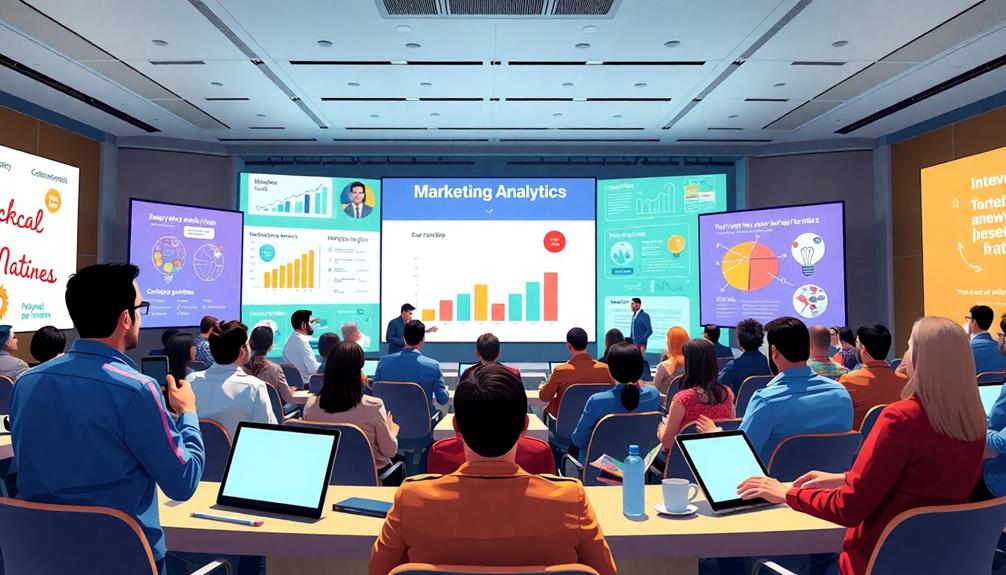If you're just starting with paid advertising, you've got a powerful tool at your fingertips. Paid ads can quickly connect you with your target audience, increase brand awareness, and deliver impressive returns on investment. You'll find various ad types like search, display, and social media ads, all tailored for different goals. It's important to define your campaign objectives, allocate a budget, and choose the right platforms for your audience. Creating compelling content is vital, too. By monitoring performance with analytics, you can optimize your strategy. Keep going, and you'll uncover more strategies for success in the world of paid advertising!
Key Takeaways
- Paid advertising involves purchasing ad space to reach targeted audiences quickly and effectively, offering immediate visibility and potential high ROI.
- Key types of paid ads include search ads, display ads, social media ads, video ads, and shopping ads, each serving different marketing objectives.
- Google Ads and Facebook Ads are popular platforms, providing advanced targeting options to connect with specific demographics and interests.
- Monitoring performance through KPIs like CTR and conversion rates is essential for optimizing ad campaigns and ensuring effective budget allocation.
- Start by defining clear campaign objectives, allocating a budget, and selecting the right platform to engage your target audience effectively.
What Is Paid Advertising?

Paid advertising is a powerful digital marketing strategy where businesses actively purchase ad space across various platforms to effectively promote their products or services. This approach encompasses various formats, such as pay-per-click (PPC) ads, display ads, social media promotions, and sponsored content. Each format provides unique advantages, allowing you to choose the best fit for your goals.
Additionally, employing tactics like reducing cart abandonment can enhance the effectiveness of your paid campaigns by guaranteeing that, once users click through your ads, they've a seamless shopping experience.
One of the most significant aspects of paid advertising is its focus on targeted audiences. By leveraging data-driven insights, you can pinpoint your ideal customers based on demographics, interests, and behaviors. This precision guarantees that your ads reach the most relevant users, maximizing your chances of engagement and conversion.
Unlike organic marketing methods, which can take time to show results, paid advertising delivers immediate visibility and traffic. This instant impact can be vital for businesses looking to boost awareness quickly.
With effective campaigns, you could experience a substantial return on investment (ROI), sometimes exceeding 200%. Integrating paid advertising into your digital marketing strategy can be a game-changer, providing the tools you need to connect with your audience and achieve your business objectives.
Benefits of Paid Advertising

When you invest in paid advertising, you get rapid access to your target audience, which can greatly boost your brand awareness.
By utilizing topical authority's role in SEO rankings and targeting specific demographics and interests, you guarantee your message reaches the right people, maximizing your impact.
This strategic approach not only enhances visibility but also helps you make the most of your advertising budget.
Rapid Audience Reach
In the fast-paced world of digital marketing, businesses can achieve immediate visibility through paid advertising, rapidly connecting with target audiences that organic methods might take months to reach.
With platforms like Google Ads and social media, you can access a global audience within minutes, guaranteeing swift brand exposure. Additionally, understanding the nuances of investment options, such as IRA investing strategies, can enhance your overall financial planning while you focus on building your brand.
Paid ads allow you to generate significant traffic increases, with effective campaigns sometimes reporting up to a 200% return on investment (ROI).
The targeting capabilities of paid advertising are invaluable, enabling you to segment your audience based on precise demographics and interests. This guarantees your ads reach the most relevant potential customers, maximizing your chances of conversion.
In competitive markets, rapid audience reach through paid advertising is essential. You need to establish your presence quickly to convert leads into sales.
While organic methods have their place, the immediacy of paid ads can give you a vital edge. By leveraging paid advertising, you can't only connect with your target audience faster but also drive engagement that leads to tangible results.
Don't underestimate the power of paid ads in building your brand's visibility and achieving your marketing goals.
Enhanced Brand Awareness
Leveraging paid advertising can dramatically enhance your brand awareness, allowing you to capture attention in crowded markets. By implementing a robust paid media strategy, you can effectively increase brand awareness and achieve measurable results. With studies indicating that businesses can see a ROI of 200% or more, the impact of well-crafted paid campaigns is undeniable.
You can reach targeted audiences based on demographics, interests, and behaviors, ensuring your brand messages hit the right people at the right time. This immediate visibility helps you establish a presence quickly in competitive markets, leading to faster recognition than organic methods.
Here's a quick overview of how paid advertising can boost your brand awareness:
| Benefit | Description |
|---|---|
| Immediate Visibility | Quickly establishes your brand in the market. |
| Targeted Reach | Connects with specific audiences effectively. |
| Measurable Performance Metrics | Allows for strategy refinement using insights. |
With paid media spending projected to reach $500 billion by 2024, investing in paid advertising is essential for enhancing your brand visibility and awareness. Start leveraging these strategies today!
Demographic Targeting Benefits
Demographic targeting revolutionizes how businesses connect with their audiences by honing in on specific characteristics like age, gender, and interests. This approach allows you to reach the right audience segments, resulting in more relevant ad placements and markedly higher engagement rates.
By utilizing platforms like Facebook and Google Ads, you can take advantage of advanced targeting options that have been shown to increase conversion rates by 20-50% compared to non-targeted ads. Additionally, just as proper planning is essential in areas such as end of life importance, effective demographic targeting requires thorough research and strategic foresight.
One of the biggest benefits of demographic targeting is its ability to reduce wasted ad spend. When your marketing messages reach individuals who are more likely to be interested in your product or service, you're spending your budget more wisely. Research indicates that campaigns utilizing demographic targeting are 2 to 3 times more effective in achieving return-on-investment (ROI) than those that employ a broad approach.
In addition, by analyzing demographic data, you can refine your marketing strategies, leading to improved customer satisfaction and loyalty. When your messages resonate better with your intended audience, you create a stronger connection that fosters long-term relationships.
Embracing demographic targeting can truly transform your paid advertising efforts.
Types of Paid Ads

Exploring the landscape of paid advertising reveals a variety of effective strategies that can elevate your marketing efforts. One popular option is paid search ads, which appear at the top or bottom of search engine results. These ads target users actively searching for specific products or services, making them a great way to reach potential customers right when they need you.
Additionally, understanding consumer behavior, like the importance of monitoring credit card statements for fraud, can help refine your targeting strategies for better engagement and conversion rates credit card insights.
Another effective strategy is display ads. These visually appealing image or video ads are placed on websites and apps, designed to capture attention and boost brand awareness. You can target these ads based on user demographics and interests for better results.
Then there are social media ads, which let you promote your brand on platforms like Facebook, Instagram, and TikTok. These ads leverage advanced targeting options, allowing you to zero in on audiences based on their behaviors and interests.
Additionally, consider video ads to tell your brand story or promote products engagingly.
Google Ads Overview

Google Ads is a robust platform that lets you create various campaign types like Search, Display, and Video ads to connect with your audience.
With its advanced targeting options, you can tailor your ads to reach specific demographics and interests, increasing the likelihood of engagement.
You can take advantage of its pay-per-click model to maximize your budget effectively.
Key Features of Google Ads
When it comes to online advertising, Google Ads stands out as a powerful tool for businesses looking to connect with their target audience. One of the key features of Google Ads is its variety of campaign types, including Search, Display, Video, Shopping, and App campaigns. This flexibility allows you to choose the format that aligns with your marketing goals and enhances your brand visibility through smart marketing strategies.
Google Ads operates on a pay-per-click (PPC) model, meaning you only pay when users click on your paid ads, making it a cost-effective option for driving targeted traffic. With over 3.5 billion searches conducted daily on Google, you gain unparalleled access to potential customers actively searching for products and services.
Additionally, Google Ads provides advanced targeting options, enabling you to reach specific demographics, geographic locations, and user behaviors. This enhances the relevance and effectiveness of your ads, ensuring you connect with the right audience.
To help you refine your strategies, Google Ads includes detailed analytics and reporting features. You can track key performance indicators (KPIs) like clicks, impressions, and conversion rates, allowing you to optimize your advertising efforts effectively.
Campaign Types and Strategies
Release the potential of your advertising efforts by understanding the diverse campaign types Google Ads offers. Each type caters to specific marketing goals, allowing you to strategically target your audience. Here's a quick overview of the main campaign types:
| Campaign Type | Description | Ideal For |
|---|---|---|
| Search | Text ads in search results targeting users actively seeking products/services. | Higher conversion rates for businesses with specific offerings. |
| Display | Image or video ads on websites and apps reaching over 90% of internet users. | Brand awareness and retargeting efforts. |
| Shopping | Product ads with images and prices directly in search results. | E-commerce businesses looking to drive sales. |
| Video | Engaging video content on platforms like YouTube. | Brands wanting to leverage user engagement. |
| App | Ads promoting app installations across Google's networks. | Businesses focused on boosting app downloads. |
Facebook Advertising Strategies

In the dynamic world of online marketing, Facebook advertising stands out as a powerful tool for businesses looking to connect with their target audience. With over 2.9 billion active users, you can easily target specific demographics, interests, and behaviors, ensuring your message reaches the right people.
Leveraging techniques such as AI-enhanced content strategies can further refine your audience targeting and improve engagement.
To maximize your campaign performance, consider using diverse ad formats like image, video, carousel, and collection ads. These formats allow you to showcase your products creatively, capturing attention and encouraging engagement.
Remember, Facebook's algorithm favors user engagement, so focus on crafting compelling ad copy and visuals.
Utilizing Facebook Pixel is another smart strategy. It helps you track user interactions on your website, enabling precise retargeting and optimization of your ad campaigns based on performance data.
Don't forget to regularly monitor insights and metrics, such as click-through rates (CTR) and conversion rates. This will be essential for refining your campaigns and maximizing your return on ad spend (ROAS).
Instagram Advertising Insights

Facebook advertising effectively reaches a wide audience, but expanding your strategy to include Instagram can amplify your brand's visibility. With over 1 billion monthly active users, Instagram's highly visual platform is perfect for engaging younger audiences like millennials and Gen Z. By leveraging Instagram ads, you can effectively showcase your products in an engaging way.
Additionally, understanding cookie categories can help you tailor your advertising strategy better. Instagram offers various ad formats, including photo ads, video ads, carousel ads, and Stories ads. These options allow you to creatively present your offerings and keep your target audiences intrigued.
Integrating Instagram's advertising capabilities with Facebook's Ads Manager provides you with advanced targeting options. You can hone in on user demographics, interests, and behaviors for more precise audience engagement.
On average, expect a click-through rate (CTR) of about 0.5% to 1.0% with Instagram ads. However, the visually driven nature of the platform often leads to higher engagement rates.
To maximize your success, make sure you have a well-defined campaign objective, whether it's brand awareness, traffic generation, or conversions. Aligning your ads with your overall marketing goals will help you achieve the best results.
TikTok Advertising Techniques

How can you effectively tap into TikTok's vibrant advertising landscape? To maximize your reach and engagement on this platform, you need to adopt smart TikTok advertising techniques tailored to its unique environment. Here are some key strategies to evaluate:
- Leverage In-Feed Ads for seamless integration into users' feeds.
- Create Brand Takeovers to captivate users with full-screen experiences.
- Launch Branded Hashtag Challenges to encourage user-generated content and foster community engagement.
- Utilize advanced targeting options to reach specific demographics based on interests and behaviors.
Additionally, understanding AI-driven solutions can enhance your advertising strategies, allowing for more personalized and effective campaigns.
To succeed, focus on crafting an engaging ad that resonates with TikTok's audience, particularly Gen Z and Millennials. Remember, the platform thrives on authentic and visually appealing content.
By using TikTok's self-serve ad platform, you can easily manage your campaigns and make real-time adjustments based on performance metrics. This approach not only helps you target specific audiences but also enhances your return on investment.
Performance Tracking Methods

Effective performance tracking is essential for any successful advertising campaign. By monitoring key performance indicators (KPIs) like click-through rates (CTR), conversion rates, and return on investment (ROI), you can understand how well your ads are performing. Tools like Google Analytics allow you to create custom reports that provide insights into which ads drive the most traffic and conversions.
To enhance your performance tracking, consider implementing A/B testing. This method involves comparing different versions of your ads to see which elements resonate better with your audience. Regular monitoring helps you identify underperforming ads, enabling real-time optimizations that can improve overall effectiveness and reduce wasted ad spend.
Here's a quick overview of some essential performance tracking methods:
| Method | Description | Benefits |
|---|---|---|
| Google Analytics | Tracks website traffic and conversions | In-depth analysis of ads |
| A/B Testing | Compares ad variations | Optimizes ad performance |
| UTM Codes | Identifies traffic sources | Detailed campaign analysis |
Getting Started With Paid Ads

Getting started with paid ads can feel overwhelming, but breaking it down into manageable steps makes it easier. First, define clear campaign objectives to guide your advertising efforts. Do you want to increase website traffic or generate leads?
Next, allocate a budget that aligns with your goals. Start small across various platforms to test their effectiveness in reaching your target users.
Here are some steps to help you get started:
- Choose the right platform: Focus on where your target audience is most active, like Google Ads or social media.
- Create compelling content: Develop persuasive copy and eye-catching visuals that resonate with your audience.
- A/B test variations: Experiment with different ad formats to see what works best for your campaign.
- Monitor performance: Use analytics tools to track click-through rates and conversions, allowing you to make real-time adjustments.
Frequently Asked Questions
How to Start a Paid Promotion?
To start a paid promotion, define your objectives, choose the right platform for your audience, set a budget, create engaging ads, and monitor performance regularly to optimize your strategy for better results.
How to Make Paid Ads Work?
To make paid ads work, define clear objectives, target your ideal audience, and use A/B testing to refine your approach. Monitor key performance indicators, and adjust your budget based on what performs best.
How Effective Is Paid Advertising?
Paid advertising's effectiveness is impressive. You'll often see immediate visibility and traffic, advanced targeting guarantees relevance, and with proper optimization, your ROI can exceed 200%. Regularly analyze performance metrics to maximize your success.
What Is the Best Form of Paid Advertising?
You'll find the best form of paid advertising hinges on your audience. Google Ads captures active searchers, while social media ads engage users by interests. Experimenting will help you discover what truly resonates with your target market.
Conclusion
To sum it up, diving into paid advertising can feel like stepping into a vast ocean of opportunities. With the right strategies and tools, you can make waves that ripple through your target audience. Remember, the benefits are immense, and each platform offers unique advantages. So, don't hesitate—start experimenting with your ads today! Your brand's visibility can skyrocket, turning your marketing dreams into reality faster than a shooting star across the night sky!










